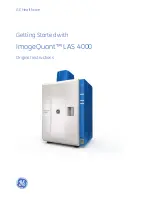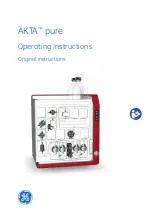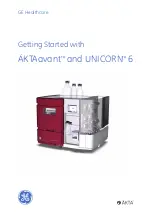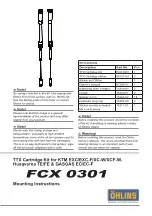
06.06
2
WA 35.
M.
-
-
-
-
E B
STARTUP
Check to make sure there is no
foreign material deposited inside the
bend, especially hard or gluey; if this
is the case, clean thoroughly.
The first startup test must be carried
out without product; if all goes well,
start feeding product and proceed
normally.
OPERATION
Suitable for fine, abrasive, products,
even those that are chemically very
aggressive.
Property:
Antistatic, for “C” version only
Permitted operating tempera-
ture:
-20° to +70°
C (peak 80°C)
Permitted operating pressure:
- Intake max. 0.5 bar
- Pressurized max. 1.5 bar
Friction factor for concentrated
losses
- ß 1.37
(
Note:
in comparison to bends
make of stainless steel, cast-iron or
other metals, technopolymer bends
are characterised by lower load
losses due to lower surface friction
and reduced adherence typical of
elastomers).
The coupling flanges are construct
-
ed in accordance with standard
UNI 2233.
They are also compatible with stand-
ard DIN 2576.
For the EB3 (3”) model, the DIN
standards envisage eight holes (in-
stead of four) and thickness differing
from those of UNI standard. They
are however compatible.
They do not conform to ANSI stand-
ards.
The flanges can be interchanged
with the wide-radius ones and
therefore comply with the same
standards.
Fit the elbow by following the
printed side.
Contact the Manufacturer if the
bend is to be applied at a height
exceeding 15 m as compared to
the line loading point.
LIMITS IN USE
Silo filling through tankers
.
Pneumatic conveying
: rare
N.B.: to avoid flow resistance keep
number of units low (2-3 per line).
Do not use for conveying in thick
phase.
I
STARTEN
Sicherstellen, dass keine Fremd-
körper innerhalb des Rohrbogens
liegen, vor allem solche, die aus-
gehärtet oder verklebt sind. Iist das
der Fall, eine sorgfältige Reinigung
vornehmen.
Der erste Startversuch ist ohne
Produkt vorzunehmen. Wenn alles
ordnungsgemäß funktioniert, mit
dem Material beschicken und nor-
mal weitermachen.
BETRIEB
Für feine, abrasive, chemisch auch
stark aggressive Produkte gee-
ignet.
Eigenschaften:
Antistatisch, nur bei Version “C”
Zulässige Betriebstempera-
turen:
von -20° bis +70°C
(Spitzenwert 80°C)
Zulässige Betriebsdrücke:
- Max. Saugdruck 0.5 bar
- Max. Förderdruck 1.5 bar
Reibfaktor für konzentrierte Ver-
luste:
- ß 1.37
(
Anm.:
Im Bezug zu Rohrbögen aus
Stahl, Gusseisen oder anderen Me-
tallen, zeichnen sich die Rohrbögen
aus technischen Polymeren durch
tiefere Strömungsverluste aus, die
auf dem geringeren Reibwert und
dem niedrigeren Haftvermögen
beruhen, die typisch für Elastomere
sind).
Die Verbindungsflansche entspre
-
chen der Norm UNI 2233.
Sie entsprechen außerdem der
DIN 2576.
Für das Modell EB3 (3”) sehen die
DIN-Normen 8 Löcher (anstatt 4)
und andere Stärken als die UNI-
Normen vor. Sie sind aber auf jeden
Fall miteinander verträglich.
Sie entsprechen nicht den ANSI-
Normen.
Sie sind mit den Rohrbögen mit
weitem Radius austauschbar und
die Flansche entsprechen daher den
gleichen Normen.
Den Rohrbogen gemäß der auf sei-
nem Körper angegebenen Richtung
montieren.
Falls die Anbringung des Rohrbo-
gens in einer Höhe über 15 m über
der Einfüllstelle der Leitung erfolgt,
wenden Sie sich an den Hersteller.
VERWENDUNGSEINSCHRÄN-
KUNGEN
Silobefüllung durch Silofahr-
zeuge.
Pneumatische Förderung:
selten
N.B.: zur Vermeidung von Strö-
mungsverlusten Anzahl so gering
wie möglich halten (2-3 St. pro
Linie).
Die Transportvorrichtung nicht für
die Dichtstromförderung benutzen.
URUCHAMIANIE
Upewnić się, że we wnętrzu kolana
rurowego nie osadziły się żadne ciała
obce, zwłaszcza takie, które mają
tendencję do przywierania i tworzenia
narostów. Jeśli tak się stało, gruntow
-
nie przeczyścić kolano rurowe.
Pierwszą próbę uruchomienia należy
przeprowadzić bez obciążenia prze
-
noszonym materiałem. Jeśli wszystko
działa prawidłowo, podać materiał i
rozpocząć regularną eksploatację.
PRACA
Kolano rurowe przystosowane jest do
transportu pneumatycznego drobno-
ziarnistych, ściernych materiałów, na
-
wet takich, które są bardzo agresywne
chemicznie.
Właściwości:
Antystatyczne, również w wersji “C”
Dopuszczalne temperatury robo-
cze:
od -20° do +70°C (w szczycie 80°C)
Dopuszczalne ciśnienie robocze:
- Maks. ciśnienie zasysania 0,5 bar
- Maks. ciśnienie tłoczenia 1,5 bar
Współczynnik tarcia dla skoncen-
trowanych strat:
-
ß 1,37
(Uwaga:
W porównaniu do kolan ru-
rowych wykonanych ze stali, żeliwa lub
innych metali, kolana wykonane z po-
limerów technicznych charakteryzują
się mniejszymi stratami przepływu,
wynikającymi ze zredukowanego
współczynnika tarcia oraz mniejszego
przywierania, typowego dla elasto-
merów).
Kołnierze przyłączeniowe są wykona
-
ne zgodnie z normą UNI 2233. Są one
również zgodne z normą DIN 2576. W
przypadku modelu EB3 (3”) normy DIN
przewidują 8 otworów (zamiast 4) oraz
inne grubości niż normy UNI. Są one
jednak ze sobą kompatybilne.
Nie są one jednak zgodne z normami
ANSI. Kołnierze można wymienić
na takie o szerokim promieniu i tym
samym są one zgodne z tymi samymi
normami.
Kolano rurowe należy zamontować
zgodnie z kierunkiem podanym na
jego korpusie.
Jeśli kolano rurowe montowane jest
na wysokości przekraczającej 15 m
nad punktem zasilania przewodu
rurowego, należy skonsultować się z
producentem.
OGRANICZENIA W STOSOWANIU
Napełnianie silosu przez cysterny.
Transport pneumatyczny:
rzadko
N.B. W celu uniknięcia strat przepływu
liczba kolan powinna być jak najmniej
-
sza (maks. 2-3 szt. na linię).
Nie używać systemu transportu pneu
-
matycznego do przenoszenia materiału
gęstym strumieniem.
AVVIAMENTO
Verificare che sostanze estranee
non si siano fermate nella curva, so-
prattutto se sono dure o collanti; se
così fosse pulire accuratamente.
La prima prova di avviamento deve
essere fatta senza prodotto; se tutto
funziona regolarmente, alimentare
con il materiale e procedere nor-
malmente.
FUNZIONAMENTO
Adatte per prodotti fini, abrasivi,
chimicamente anche molto ag-
gressivi.
Proprietà:
Antistaticità, solo per la versione
“C”
Temperature di lavoro ammes-
se:
da -20° a +70°C (picco 80°C)
Pressioni di esercizio ammesse:
- Aspirazione max 0.5 bar
- In pressione max 1.5 bar
Fattore di attrito per perdite con-
centrate:
- ß 1.37
(
Note:
rispetto a curve in acciaio,
ghisa o altri metalli, le curve in
tecnopolimero si caratterizzano per
valori di perdite di carico inferiori,
dovuti al minor attrito superficiale
e alla bassa aderenza tipica degli
elastomeri).
Le flange di accoppiamento sono
realizzate secondo le norme UNI
2233.
Sono inoltre compatibili con le nor-
me DIN 2576.
Per il modello EB3 (3”) le norme
DIN prevedono n°8 fori (anzichè 4)
e spessori diversi dalle norme UNI.
Sono comunque compatibili.
Non rispettano le norme ANSI.
Sono intercambiabili con quelle a
raggio largo pertanto le flange ri
-
specchiano le medesime norme.
Montare la curva seguendo il verso
stampato sul corpo della stessa.
Nel caso in cui l’applicazione della
curva sia ad una altezza superiore
ai 15 m rispetto al punto di cari
-
camento della linea, contattare il
Costruttore.
LIMITI DI UTILIZZO
Caricamento silo con autoci-
sterne.
Trasporti pneumatici in fase dilu-
ita:
raramente
N.B. per evitare perdite di carico
importanti limitarne l’impiego (max
2-3 curve per linea).
Non utilizzare per trasporto in fase
densa
~=
~=
~=
~=
03
OPERATION AND MAINTENANCE
BETRIEBS- UND WARTUNGSANLEITUNG
INSTRUKCJA OBSŁUGI I KONSERWACJI
USO E MANUTENZIONE






























